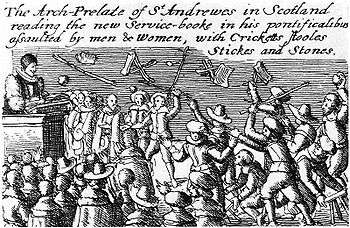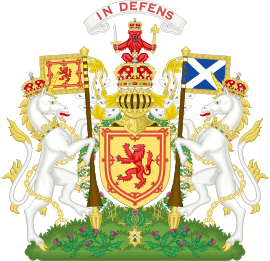Bishops' Wars
| Bishops' Wars | |||||||
|---|---|---|---|---|---|---|---|
| Part of the Wars of the Three Kingdoms | |||||||
| |||||||
| Belligerents | |||||||
|
|
| ||||||
| Commanders and leaders | |||||||
|
|
| ||||||
| Strength | |||||||
| 15,000+ | 24,000+ | ||||||
| Casualties and losses | |||||||
| 300 approx. | 200 approx. | ||||||


The Bishops' Wars (Latin: Bellum Episcopale) were conflicts, both political and military, which occurred in 1639 and 1640 centred on the nature of the governance of the Church of Scotland, and the rights and powers of the Crown. They constitute part of a larger political conflict across Scotland, England and Ireland, and are often considered a prelude to the English Civil Wars. They were so named due to the central conflict between Charles I, who favoured an episcopal system of church government for Scotland (that is, with bishops), and the desire of much of the polity of Scotland for a presbyterian system of governance (without bishops).
Origins
James VI of Scotland had reintroduced episcopacy to the Church of Scotland in 1584. After acceding to the English throne, he increased the numbers of bishops. His son, Charles I continually tried to foster uniformity between the established churches of his realms following the Anglican model. His regulation of liturgy in Scotland through the imposition of a Book of Common Prayer in 1637 sparked rioting and led to a formalised opposition in the National Covenant. His attempts to control the situation from London were unsuccessful, and by July 1638 he decided in his English Privy Council that force would have to be used. To gain time he agreed to a General Assembly of the Church of Scotland which met at Glasgow in November 1638, but the Assembly firmly decided that bishops were to be deposed and the prayer book abolished. Support for the Covenant grew under the leadership of James Graham, 1st Marquess of Montrose and Archibald Campbell, 8th Earl of Argyll, while soldiers serving abroad returned to Scotland, including General Alexander Leslie.
First Bishops' War (1639)

Despite problems in raising funds, Charles gathered a poorly trained English force of around 20,000 men in the early summer of 1639 and marched to the vicinity of Berwick-upon-Tweed on the English side of the border. The Scottish army, of some 12,000 men, led by Leslie, were encamped a few miles away on the other side of the border near Duns.[1] Meanwhile, a series of minor engagements between Covenanters and Scottish royalist forces took place in Aberdeenshire. The first was a confrontation at the small town of Turriff called the "Raid of Turriff" at which no blood was shed.[2] The next was the siege of Towie Barclay Castle, in which one person was shot – the very first casualty of the Wars of the Three Kingdoms.[3] This was followed by two minor engagements known as the "Trot of Turriff" and the battle of the Brig o' Dee to the south of Aberdeen.[4] However, as neither of the main armies wanted to fight, a settlement called the Pacification of Berwick was reached in June under which the king agreed that all disputed questions should be referred to another General Assembly or to the Parliament of Scotland.
Interlude
The new General Assembly then re-enacted all the measures passed by the Glasgow Assembly, and the Scottish Parliament went further, abolishing Episcopacy and declaring itself free from Royal control.
Charles, believing that the Scots were intriguing with France and that under these circumstances, the English would be more ready to rally to his standard, once more called an English parliament – after having ruled alone in England for eleven years. In April 1640, the so-called Short Parliament convened but first demanded redress of grievances, the abandonment of the royal claim to levy ship money, and a complete change in the ecclesiastical system. Charles considered these terms unacceptable and dissolved parliament.
Second Bishops' War (1640)
Thomas Wentworth, now earl of Strafford, became the leading adviser to the King. He threw himself into Charles’s plans with great energy and left no stone unturned to furnish the new military expedition with supplies and money.
The Scots under Leslie and Montrose crossed the River Tweed, and Charles’ army retreated before them. In a short time, the invaders overran the whole of Northumberland and County Durham (see Battle of Newburn). Charles had to leave the two counties in Scots hands as a pledge for the payment of Scots expenses when he agreed to peace and signed the Treaty of Ripon in October 1640. The impoverished King had to summon another parliament to grant him the supplies which he needed to make that payment; this Long Parliament attacked his Government, impeaching (and eventually executing) his chief supporters, Strafford and Laud. It sat until purged in 1648.
In the hopes of winning Scottish support, Charles went to Scotland in the autumn of 1641 where he gave titles to Leslie and Argyll, and accepted all the decisions of the General Assembly of 1638 and of the Scottish Parliament of 1641, including confirming the right of the Parliament to challenge the actions of his ministers. He had now withdrawn all the causes of the original dispute, but within a year his disputes with the English Parliament would lead to civil war.
Aftermath
The Bishops' Wars triggered civil war in Charles' other two Kingdoms, first in Ireland, then in England, eventually a larger political conflict across Scotland, England and Ireland, and are often considered a prelude to the English Civil Wars.
See also
- English Civil War timeline
- Wars of the Three Kingdoms
- Scotland in the Wars of the Three Kingdoms
- Bishops in the Church of Scotland
References
- ↑ Trevor Royle (2005) Civil War: The Wars of the Three Kingdoms. London, Abacus: 94
- ↑ Trevor Royle (2005) Civil War: The Wars of the Three Kingdoms. London, Abacus: 89
- ↑ Trevor Royle (2005) Civil War: The Wars of the Three Kingdoms. London, Abacus: 91
- ↑ Trevor Royle (2005) Civil War: The Wars of the Three Kingdoms. London, Abacus: 91–3
Further reading
Primary
- Baillie, Robert, Letters and Journals, 1841.
- Calendar of State Papers Domestic of the Reign of King Charles I, 1858–97.
- The Register of the Privy Council of Scotland, variously edited, 1899–1933.
- Rothes, John Leslie, earl of, A Relation of the Proceedings of the Affairs of the Kirk of Scotland, from August 1637 to July 1638, 1830.
- Rothiemay, James Gordon of, History of Scots Affairs from 1637 to 1641, 1841.
- Warriston, Archibald Johnston of, Diaries, variously edited, 1911–1940.
Secondary
- Donald, P., An Uncounselled King. Charles I and the Scottish Troubles, 1637–1641, 1990.
- Fissel, M. C., The Bishops’ Wars. Charles I’s Campaigns against Scotland, 1638–1640, 1994.
- Lee, M., The Road to Revolution. Scotland under Charles I, 1985.
- McCoy, F. N., Robert Baillie and the Second Scots Reformation, 1974.
- MacInnes, A. I., Charles I and the Making of the Covenanting Movement, 1991.
- Russel, C, The Fall of the British Monarchies, 1637–1642, 1991.
- Stevenson, D., The Scottish Revolution, 1637–1644, 1973
External links
- An interactive map and timeline of the events leading to the First Bishops' War, the events of the war, and the three main actions of the war: Turriff, Megray Hill, and the Bridge of Dee.
